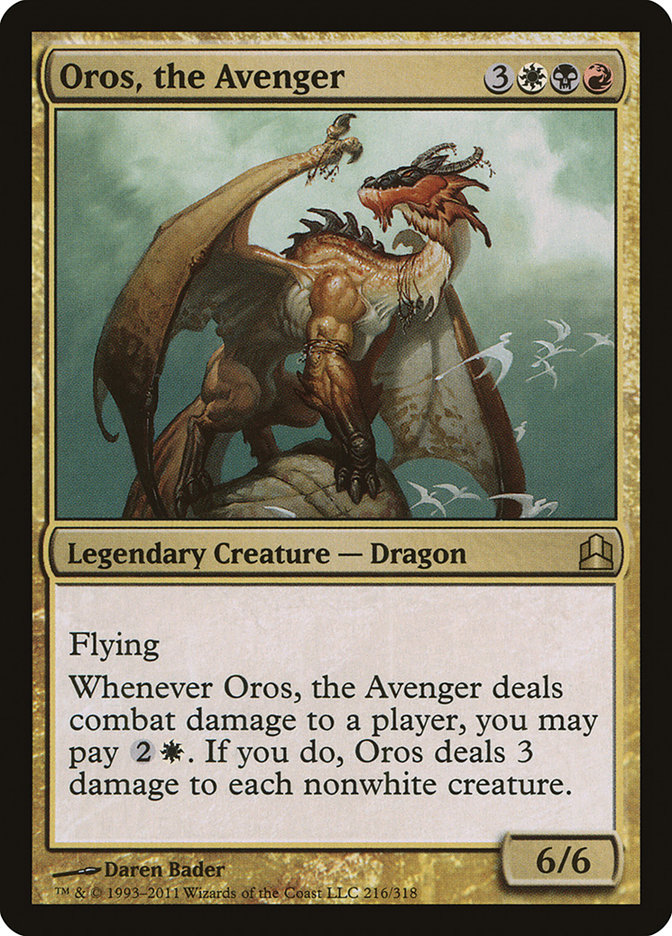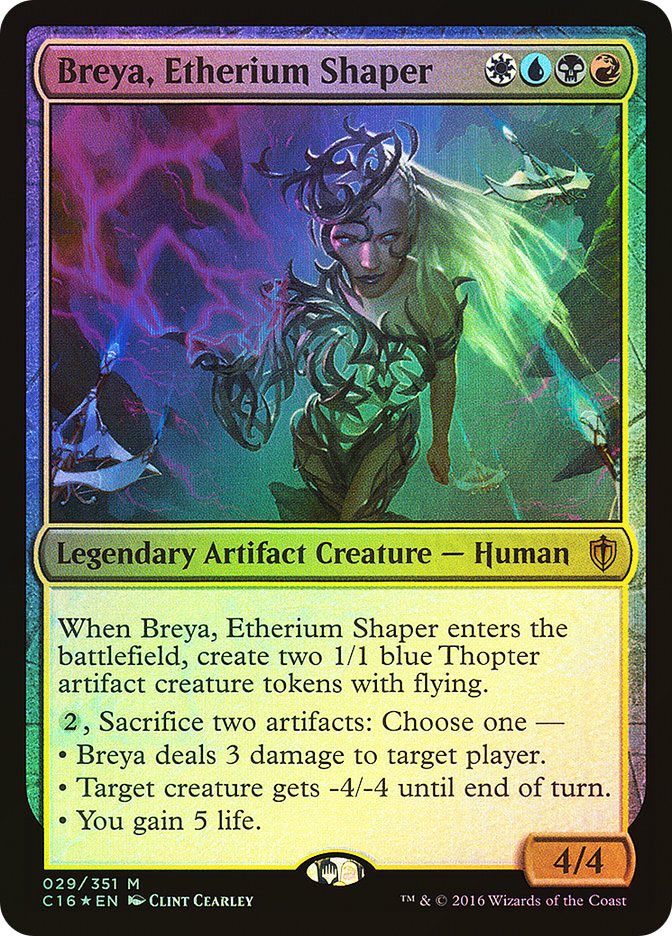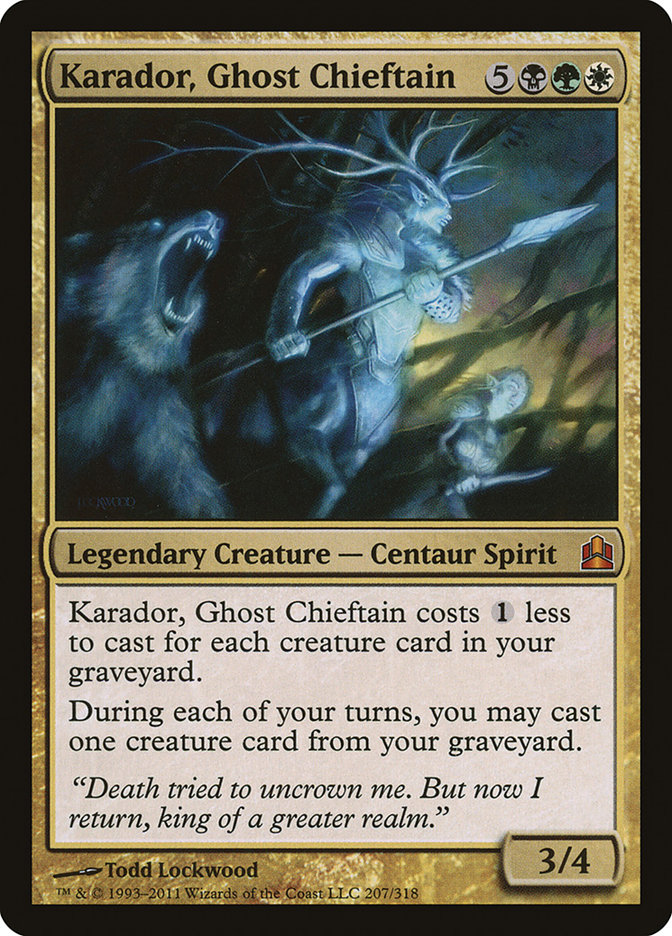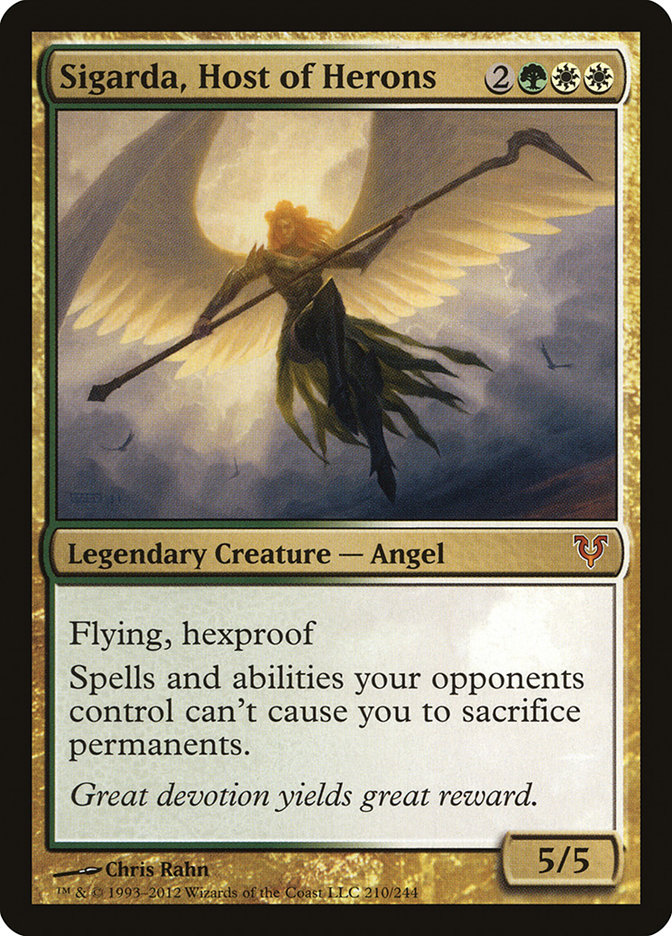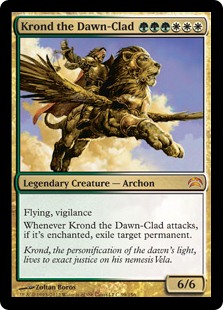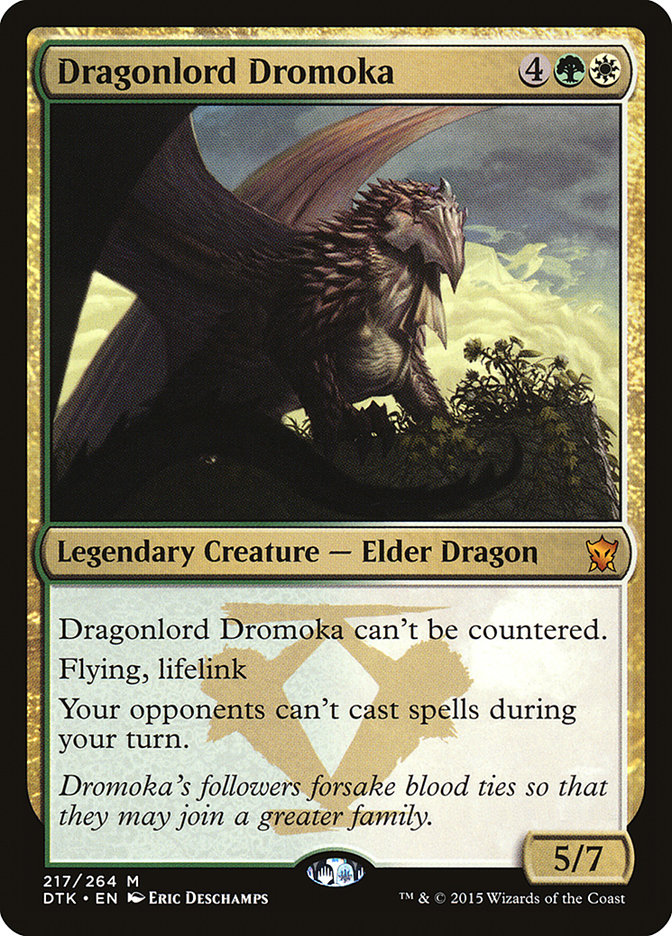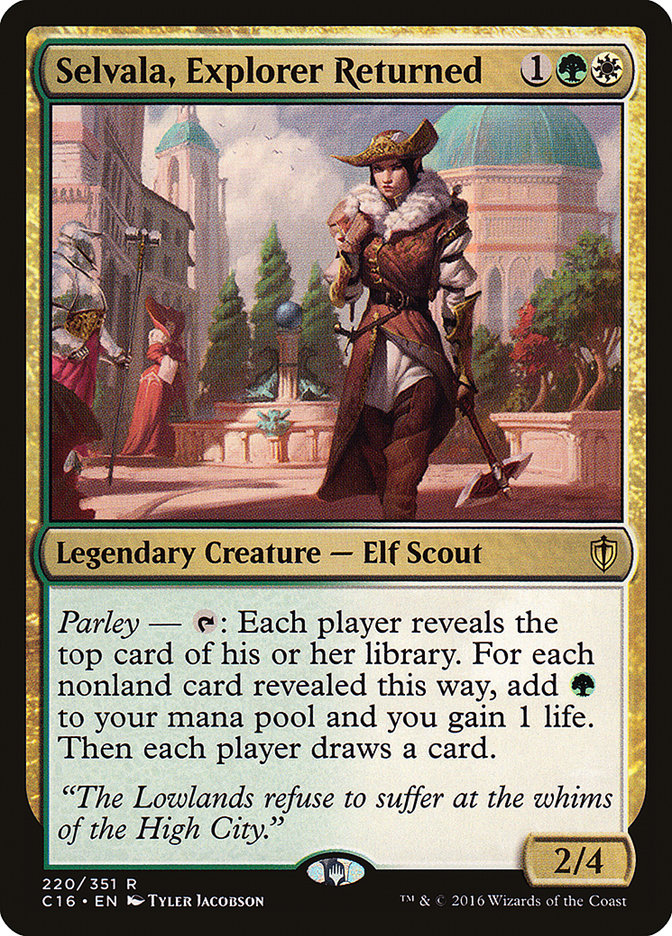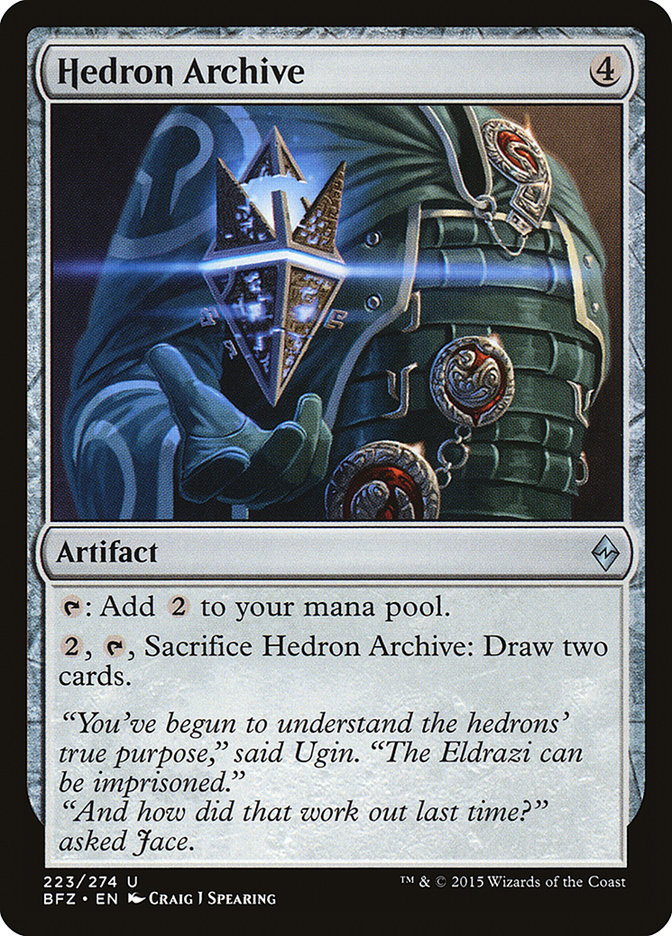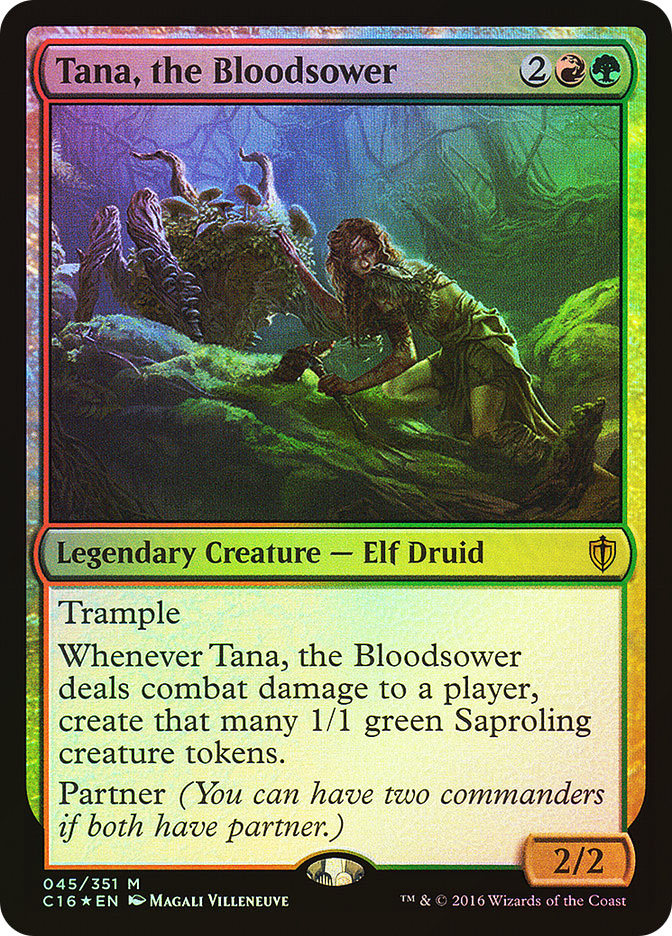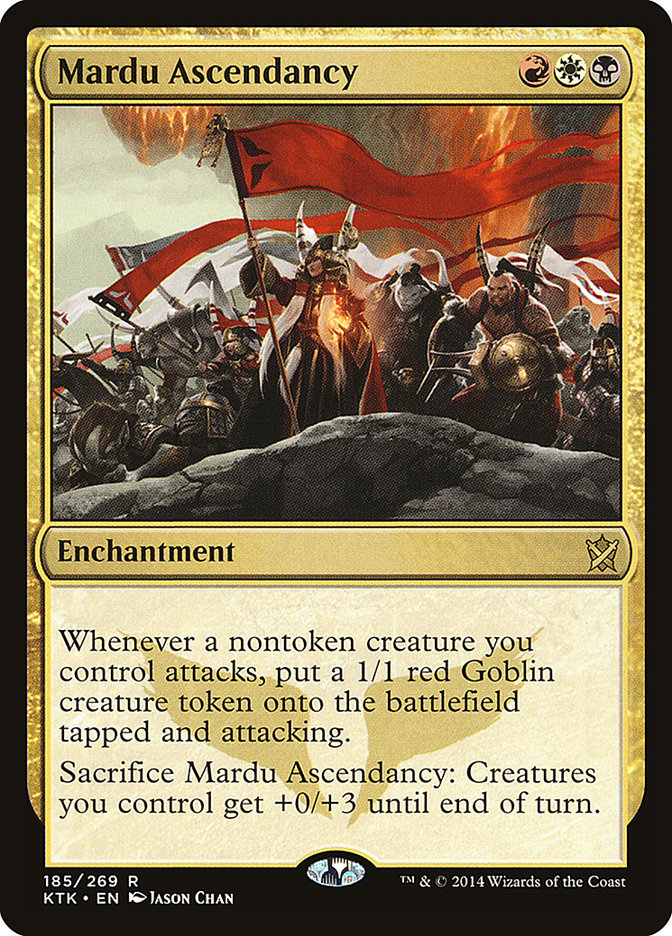I love when coincidences create inspiration. Last week I read Andrew Magrini’s post about Splash Theory and it sparked an idea. I had a discussion with my friends about the four-color commanders and how likely we were to use them. My friend Buro won’t build even a three-color deck because he feels he cannot make the mana work, while my friend John is so hyped for the new Commander product that he is planning to build around all five of them.
With their discussions and Andrew’s blog post, I was thinking of how I balance the colors between my decks. My favorite deck, Oros, the Avenger, is a B/W deck that dips into red to round things out.
Although white and black can answer most permanents, the touch of red allows me to add a few effects that would be much weaker without red mana.
The new four-color commanders are going to give us ample opportunity to splash colors. For example, Breya, Etherium Shaper can easily be a U/R artifact deck with a splash of white cards for support and black for about two cards in the 99.
Or she can be built like an Esper artifact deck with a splash of red for Daretti, Scrap Savant and a couple of other cards like Goblin Welder and Scrap Mastery.
How Do I Splash?
You don’t want to just start throwing colors into a deck without a purpose. You want to splash with effect. Don’t be a Magikarp.
You need to identify a focus. I know that I use this advice for… well, everything. But lots of people just act and make more mistakes than are necessary, or spend money buying cards they won’t use and can’t get the ones they need. Andrew suggests finding a theme or focus for two colors. For splash theory to work, you are not focusing on the third (or fourth) color. His goal is a strong two-color deck with a supplement from the other color.
Three-color decks allow the easiest splashing. Four-color decks present more choices. The Breya example above shows just two options, but a Grixis artifact deck splashing a couple of white cards to return artifacts from the graveyard to the battlefield is entirely possible.
Either way, for Andrew’s approach to splashing, you need to focus on a strong two-color deck. When you are splashing, you want the splash to be worth it.
Sometimes your chosen commander requires the splash: a three-color commander with only two colors of mana is a commander that never leaves its lofty perch.
If you are planning a splash for weak effects, it may be better to build the deck with only two colors. Andrew uses Karador as an example deck, but there are several potential commanders that could facilitate a G/W enchantment-focused deck, like Krond the Dawn-Clad; Dragonlord Dromoka; Selvala, Explorer Returned; or Sigarda, Host of Herons.
Each of these provides a different direction and a strong foundation. But when you want more recursion and some extra access to things like Debtor’s Knell, Daxos’s Torment, or Doomwake Giant, then black needs to go into the deck. Teneb, the Harvester could work. But Karador, Ghost Chieftan gives the strongest options for recurring the little value creatures that make Andrew’s deck work best.
Adding Mechanics
Andrew’s example brings us to the second important point in Splash Theory, the mechanics. The biggest draw to splashing is getting a high reward out of a risk-reward gamble. This is most important to tournament players, but every lesson in tournament Magic is a useful tool in more casual settings.
Adding a third color makes your manabase worse. In Modern and Legacy, adding a third color opens you up to stronger hate cards and increases the chances that you can’t cast the spell you need right now because of your manabase. In Standard, the third color rarely opens up the same hate options, but it definitely can impede your mana development. Running an Evolving Wilds to get a tapped Mountain means you can’t cast the Harnessed Lightning until your next turn. You get the spells you need, but your timing gets interrupted.
For Commander games, the risk is lighter. However, ignoring that risk is still detrimental. The player with three colors who goes hog-wild with dual lands is in for a rough time if an opponent brought Blood Moon, Magus of the Moon, or Ruination. You are likely to take more damage from shocklands and painlands. Two life for an untapped Steam Vents is almost always worth it, but the four damage from a Battlefield Forge combined with the Steam Vent and Hallowed Fountain is nearly a quarter of your life. It might not matter, but maybe a player in your pod is playing an aggressive Wort, Boggart Auntie deck and you cost yourself the game trying to cast some spells.
However, if you splash for some cards like Pyroclasm or Earthquake, then the tools you have will buy you enough time against the aggressive Goblin deck to take control. Meanwhile, you are sweeping away utility creatures the other players are casting while advancing your gameplan to keep the battlefield clear for your big threats like Sun Titan.
Adding mechanics gives you powerful incentives in splashing. The most common splash I see is to shore up a weakness in removal. This is not usually creature removal; most colors have some access, even if it is a bit temporary. Rather, removing all different types of permanents can become a challenge.
Artifacts and enchantments are particularly tricky for several colors to deal with. White and green can destroy both all day long. Red can easily handle artifacts. Black has one or two ancient cards to remove an artifact and nothing to interact with enchantments. Red is similarly unable to touch enchantments (a single Chaos Warp doesn’t count). Then blue can temporarily remove either with a bounce spell, but that might not change anything. Countering the spells works but only if you have the counterspell in hand and the mana open when the Mirari’s Wake is cast.
Dipping into green or white provides a great deal of utility. A U/R Spells deck with Melek, Izzet Paragon can pretty easily shift into a Temur Spells deck with Riku of Two Reflections or Intet, the Dreamer. This provides more ramp power and access to enchantment removal in spades.
Another splash I see regularly is dipping into a color for card drawing. I personally hate this splash, as very color can generate card advantage. Blue and black provide the most straightforward examples. Green can draw off effects that care about the number of creatures (Shamanic Revelation) or off the size of a creature (Greater Good and Soul’s Majesty).
White does need to work to draw cards, harder than any other color, but there are also ways to get card advantage to help make up the ground. White can find lands to pseudo-draw with Land Tax and Weathered Wayfarer or just draw cards with Mentor of the Meek effects. Red often doesn’t add cards to hand, instead exchanging cards with Faithless Looting-type effects. However, Wheel spells (Wheel of Fortune or Reforge the Soul) do a great deal for card advantage, especially given how easily red decks can use up cards in hand. Mixing in Flashback spells to take advantage of this provides more card advantage options.
If those options don’t work, adding some artifacts to the mix can help with card-drawing potential. Mind Stone, Hedron Archive, and Dreamstone Hedron generate mana early and turn into more cards later in the game. Mind’s Eye can give you a huge amount of cards over a game. Trading Post allows you to draw cards, Ichor Wellspring provides them upon entering the battlefield and going to the graveyard, and Tower of Fortunes can help give you oodles of cards if your deck can make a lot of mana.
I have also seen people splash for ramp cards. This is almost always adding green to the deck. Don’t. Not for this. When you start adding ramp spells, which are early-game cards, you shift your deck to have a green base. This is fine, but it’s no longer splashing.
Adding in a color for a few specific tutors is something I can get behind. A deck that needs a couple of key spells can add black, blue, white, or green depending on what type of card needs to be found and what the deck is doing. White helps find enchantments or Equipment, blue can find artifacts or spells, green finds creatures and specific lands, and finally black can find anything. Red doesn’t do as well at splashing for tutor effects. It does have a lot of specific tutors for things like Dwarves, Goblins, or Dragons.
I personally like splashing for some tutors to help find critical components. I do this more in 60-card multiplayer games, but it works just the same if your commander leans in a different direction. Jenara, Asura of War could easily lead a G/W-focused deck and the blue can help find some key spells or supplement some Equipment tutoring with general artifact searching. Fabricate can find Umezawa’s Jitte just as easily as Steelshaper’s Gift, plus it can find some mana rocks or Scroll Rack in a pinch.
The other splash is running a smattering of cards to round out a deck. In a Bant deck a little soft to fliers but leaning hard on U/W, you can add fliers, but that might take away from the deck. Adding Hurricane, Squall Line, and Silklash Spider can provide a lot of power to both hurt opponents and wipe out some pesky Thopters.
Partner Impact
The partner mechanic changes how we can splash in decks. Under normal circumstances, splashing a color can disrupt your plan to cast your commander easily. Partner allows you to focus the deck on a single commander and use the other as backup. Perhaps your deck is focused on Vial Smasher the Fierce but you wanted a few ways to protect yourself and a bit of card drawing; partnering with Tymna the Weaver provides card drawing, some big token spells like Secure the Wastes, lifegain, and protection effects. The best part is that your deck may not need white at all until the mid- to late-game, so you can run significantly fewer white sources and continue your gameplan with Vial Smasher the Fierce.
You can use the partner mechanic to splash for a lot of different effects. Tana, the Bloodsower can work effectively with Ludevic, Necro-Alchemist to gain some extra cards. As a bonus, access to blue allows the use of unblockable effects like Teleportal and Distortion Strike without having to dive deep into using blue cards.
You can also splash with partners in a similar manner as splashing a four-color commander. Partnering Ishai, Ojutai Dragonspeaker and Reyhan, Last of the Abzan can allow you to run an Abzan deck that does a lot with counters while adding blue for a couple of extra effects. Ishai is a viable threat that requires little work on your part. You can also add effects like Deepglow Skate, aka “Bubbling Season,” and Fathom Mage to generate extreme value and keep cards flowing.
Oros, the Example
My Oros, the Avenger deck is splashing red for a few effects. Bloodfire Colossus, Inferno Titan, and Embermaw Hellion help pressure opponents with direct damage and supplement Oros’s effect. Access to red amplifies the removal and increases my Sun Titan targets. Fulminator Mage can hold a Sword of Fire and Ice to make the early-game more powerful and in the mid- to late-game it can destroy problem lands. Sun Titan brings it back to repeatedly destroy issues like Cabal Coffers and Rogue’s Passage. Viashino Heretic gives incidental damage and repeated artifact destruction, but the real boost is how much it threatens and changes the artifact-focused decks. When an opponent will not get a Darksteel Colossus with a Muzzio, Visionary Architect, then you know the card is doing its job.
Red also assist my subtheme of tokens with Mardu Ascendancy and Daretti, Ingenious Iconoclast. Daretti provides tokens, an extra bit of removal, and a terrifying ultimate. Fun fact: if you land Daretti on the second turn, it will ultimate. Daretti, Ingenious Iconoclast’s tokens have defender, but extra blockers allow you to attack more recklessly and they’re colorless for Voltron decks hiding beneath a pile of Swords of Value and Stuff.
After that, Oros is rounded out with another unconditional removal spell and Wild Ricochet. Using Wild Ricochet when an X spell for lethal is being thrown at your face is one of my favorite plays in Commander. Just copying a good spell will usually allow Wild Ricochet to “break even” for the four mana; copying huge spells can be game-breaking for just 2RR.
Creatures (19)
- 1 Solemn Simulacrum
- 1 Withered Wretch
- 1 Weathered Wayfarer
- 1 Viashino Heretic
- 1 Bloodfire Colossus
- 1 Necrotic Sliver
- 1 Stonehewer Giant
- 1 Fulminator Mage
- 1 Baneslayer Angel
- 1 Stoneforge Mystic
- 1 Inferno Titan
- 1 Sun Titan
- 1 Harvester of Souls
- 1 Ashen Rider
- 1 Baleful Force
- 1 Angel of Finality
- 1 Magister of Worth
- 1 Butcher of the Horde
- 1 Embermaw Hellion
Planeswalkers (6)
- 1 Sorin, Lord of Innistrad
- 1 Elspeth, Sun's Champion
- 1 Ob Nixilis of the Black Oath
- 1 Nahiri, the Lithomancer
- 1 Kaya, Ghost Assassin
- 1 Daretti, Ingenious Iconoclast
Lands (37)
- 5 Plains
- 1 Reflecting Pool
- 1 Volrath's Stronghold
- 5 Swamp
- 4 Mountain
- 1 Scrubland
- 1 Plateau
- 1 Badlands
- 1 Shizo, Death's Storehouse
- 1 Bloodstained Mire
- 1 Temple of the False God
- 1 Boros Garrison
- 1 Sacred Foundry
- 1 Sunhome, Fortress of the Legion
- 1 Godless Shrine
- 1 Orzhov Basilica
- 1 Blood Crypt
- 1 Terramorphic Expanse
- 1 Reliquary Tower
- 1 Arid Mesa
- 1 Marsh Flats
- 1 Bojuka Bog
- 1 Evolving Wilds
- 1 Command Tower
- 1 Vault of the Archangel
- 1 Nomad Outpost
Spells (37)
- 1 Swords to Plowshares
- 1 Sol Ring
- 1 Demonic Tutor
- 1 Mana Crypt
- 1 Diabolic Tutor
- 1 Darksteel Ingot
- 1 Terminate
- 1 Akroma's Vengeance
- 1 Sword of Fire and Ice
- 1 Skullclamp
- 1 Promise of Power
- 1 Loxodon Warhammer
- 1 Lightning Greaves
- 1 Phyrexian Arena
- 1 Insurrection
- 1 Mind Stone
- 1 Thran Dynamo
- 1 Vindicate
- 1 Debtors' Knell
- 1 Mortify
- 1 Return to Dust
- 1 Damnation
- 1 Austere Command
- 1 Wild Ricochet
- 1 Path to Exile
- 1 Basilisk Collar
- 1 Sword of Feast and Famine
- 1 Swiftfoot Boots
- 1 Elbrus, the Binding Blade
- 1 Chromatic Lantern
- 1 Debt to the Deathless
- 1 Read the Bones
- 1 Mardu Ascendancy
- 1 Utter End
- 1 Commander's Sphere
- 1 Thought Vessel
- 1 Anguished Unmaking

Wrap-Up
Commander has many options in both building and playing. You can approach decks with a balanced perspective or lean towards only some of the colors to focus the deck more. Like eating a Reese’s, there is no wrong way.
What do you think of Splash Theory? Do you splash in your three-color decks? What are your plans with four-color decks?


